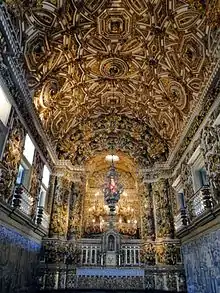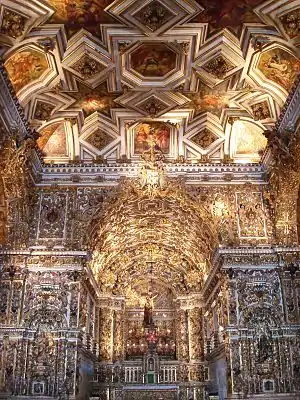Church and Convent of São Francisco, Salvador
The São Francisco Church and Convent of Salvador (Portuguese: Convento e Igreja de São Francisco) is located in the historical centre of Salvador, in the State of Bahia, Brazil. The ornate Church of the Third Order of Saint Francis sits adjacent to the convent. The friars of the Franciscan Order arrived in Salvador in 1587 and constructed a convent and church on the site. This structure was destroyed by the Dutch during the Dutch invasions of Bahia in the next century; Father Vicente das Chagas initiated the current structure in 1686, which was completed in the 18th century. The Franciscan church and convent have the largest number of azulejos, 55,000, of any church in Latin America.[1][2]
| São Francisco Church and Convent of Salvador | |
|---|---|
Convento e Igreja de São Francisco | |
_(cropped).jpg.webp) Façade of the São Francisco Church | |
| Religion | |
| Affiliation | Catholic |
| Rite | Roman Rite |
| Location | |
| Municipality | Salvador |
| State | Bahia |
| Country | Brazil |
 Location of the Catedral Basílica de Salvador | |
| Geographic coordinates | 12.9746°S 38.5091°W |
| Direction of façade | Northwest |
National Historic Heritage of Brazil | |
| Designated | 1938 |
| Reference no. | 86 |
The convent and its church are important colonial monuments in Brazil. It was listed as a historic structure by the National Institute of Historic and Artistic Heritage in 1938. The convent, church, and Church of the Third Order are one of the Seven Wonders of Portuguese Origin in the World and form integral parts of the UNESCO World Heritage Site Historic Center of Salvador.[3]
History
The friars of the Franciscan Order arrived in Salvador in 1587 at the invitation of Dom Antônio Muniz Barreiros, third Bishop of Bahia. Their arrival in Bahia followed that of the Jesuits, who arrived with Tomé de Sousa, Brazil's first governor-general, and constructed their college and chapel of the Jesuits 1564. Friar Melchior de Santa Catarina, Custodian Priest of Olinda, sent an appeal in 1585 to Pope Sixtus V to establish a convent on the site. The Franciscans initially settled into various residences and chapels on the site of the present Franciscan church, convent, and Third Order church. Melchior de Santa Catarina sent Antônio da Ilha and Francisco de São Boaventura, Franciscan brothers, to Salvador the same year; construction of a convent began in 1587.[4][1][2][5]
The Franciscans soon built a convent and church, but these were destroyed during the Dutch invasions of Bahia in the 17th century. The works on the current convent began in 1686 under Father Vicente das Chagas following a grandiose design that took decades to complete.[1][2][5]
Construction on the present-day church and convent began in 1708, as evidenced by the placement of a foundation stone. The structure was completed in 1723. The interior was decorated by several artists during a great part of the 18th century. Most decoration of the church and convent were finished by 1755. The construction of the Church of the Third Order of Saint Francis, located immediately adjacent to the Franciscan church, was carried out in parallel between 1702 and 1870.[1][2][5]
Structure


Major elements of the church are constructed of Bahian sandstone, including the walls, pilasters, and façade; some sandstone existed on the Itapagipe Peninsula in the 18th century, but later sandstone elements were brought from Jaguaribe and Velha Boipeba in the interior of Bahia. The eight massive columns that support the choir are of Bahian sandstone and display clasts characteristic of sandstone the region.[6][5]
The church consists of a nave and chancel; transept; choir; lateral corridors; a vestibule which serves as an entrance; a sala do capítulo, a large cloister; which serves as a meeting room for the order; sacristy; library; and numerous rooms that serve the convent.[6]
The Church of São Francisco of Salvador is unusual among Franciscan houses of Northeast Brazil in that it has a nave with three aisles, while most other Franciscan churches of the region have only one aisle. Three lateral chapels are located on each of the lateral aisles. The church has a rectangular shape without protruding transept arms and a main chapel. The floorplan seems influenced by the São Francisco Church of Oporto (actually a Gothic building) and the Jesuit plans of São Roque in Lisbon and the Jesuit Church of Salvador.[6]
Façade
The main façade faces a large rectangular square, the Largo do Cruzeiro, with a large stone cross. The façade shows influences of Mannerist architecture through the Jesuit Church of Salvador, among other buildings. Sandstone from the Boa Viagem quarry, located on the Itapagipe Peninsula, was used for the façade. The quarry was a donation to the Franciscan fathers. Like the Cathedral of Salvador, it has three portals and two flanking towers. The upper part of the façade (gable) is flanked by elaborate volutes. The center of the monumental pediment has a statue of Saint Francis of Assisi in white marble. It is now covered in layers of paint and placed in the niche at the end of the first half of the 18th century. A relief of the coats of arms of the Franciscan Order is placed above the statue. The smooth tiles covering the towers are also from a later period and serve further to accentuate the main body of the façade was originally in dark sandstone. Tiles were added at a later period "to accentuate the main body of the façade".[1][6]
Cruzeiro de São Francisco
A large cross in lioz marble, imported from Lisbon, sits in the broad square in front of the church. A large cross was common to Franciscan churches in Brazil; it demarcated the sacred space of an urban area. The cruzeiro of the São Francisco Church stands 8 metres (26 ft) on a square base of 5.5 metres (18 ft) by 5.5 metres (18 ft). The cross is dated 1807 and has an inscription Latin. The square in front of the São Francisco Church is now named for the cross, and is known as the Largo do Cruzeiro de São Francisco. Despite its location in a public space, the cruzeiro belongs to the Third Order of Saint Francis of Salvador.[1][7]
Cloister
The cloister of the São Francisco Church and Convent was constructed between 1707 and 1752. It consists of two stories. Stone was ordered from Boipeba Island in present-day Cairu, Bahia, to construct the cloister by Frei Alvaro da Conceição. The cloister is circled by arches supported by stone columns. Monumental blue-and-white azulejo tile panels were placed around the entirety of the cloister in the final period of construction; they were inspired by the prints of the Flemish artist Otto van Veen (c.1556 – 6 May 1629). The azulejos, 37 in number, depict mythological scenes with moralistic allegories by the Roman poet Horace. The azulejos were manufactured in Portugal, and arrived in Bahia between 1743 and 1746; their installation was completed in 1748. The cloister served as a place for meditation, community gatherings, interior processions, and other liturgical activities.[8][1][9][2]
Sacristy
The sacristy of the São Francisco Church and Convent is located directly behind the high altar and is accessed via chapels to either side of the chancel. It has a massive sacristy cabinet with an altar at center and other carved Baroque furniture. The walls are covered in 17th-century Portuguese azulejos; the ceiling is elaborately coffered. The lavabo is in white and red lioz limestone with the motif of the Franciscan order at center, an image in the niche at top, and elaborate masks motifs at the two taps.[5]
Art

The most important characteristic of the church is its exuberant inner decoration, mostly executed in the first half of the 18th century. All surfaces inside - walls, pillars, vaults and ceilings - are covered by golden sculpted gilt woodwork and paintings. The altarpieces display Solomonic columns and concentric arches decorated with golden foliage, angels and birds, while the vaults of the aisles are covered by wooden panels with paintings. Of particular note are the carvings of eight massive Atlanteans support the lateral altars.[8][9]
Blue-white tile (azulejo) panels, by Bartolomeu Antunes de Jesus and imported from Lisbon, cover the lower parts of the walls of the main chapel and transept and depict scenes of the life of St Francis of Assisi. The decoration of the church is considered one of the most complete and imposing in Portuguese-Brazilian Baroque gilt woodwork art (talha dourada), being a perfect example of the "golden church" (igreja dourada).[8][9]
The convent of São Francisco is also an important repository of Baroque art. The wooden ceiling of the entrance hall (Portaria) was painted with scenes in illusionistic perspective by José Joaquim da Rocha in 1774.[8]
Protected status
The São Francisco Church and Convent was listed as a historic structure by the National Institute of Historic and Artistic Heritage in 1938. The structure was registered under the Book of Historical Works, Inscription no. 1 and Book of Fine Arts, Inscription no. 11. The directive is dated March 31, 1938.[3]
Access
The church is open to the public and may be visited.
References
- Lins, Eugénio Ávila (2012). "Parish Church of Our Lady of Purification". Lisbon, Portugal: Heritage of Portuguese Influence/Património de Influência Portuguesa. Retrieved 2019-01-15.
- Alves, Marieta (1964). Igreja do Pilar. Pequeno guia das igrejas da Bahia, 9 (2 ed.). Salvador, Bahia: Diretoria do Arquivo, Divulgação e Estatística da Prefeitura do Salvador.
- Carrazzoni, Maria, ed. (1980). Guia dos bens tombados (in Portuguese). Rio de Janeiro, RJ: EXPED-Expansão Editorial. pp. 56–57. ISBN 9788520800577.
- Flexor, Maria Helena Ochi (2011). Igrejas e conventos da Bahia = Churches and convents of Bahia. Brasília, Brazil: IPHAN. pp. 37–70. ISBN 9788573341744.
- Silva, Zenaide C. Gonçalves (2008). O lioz português : de lastro de navio a arte na Bahia (in Portuguese). Rio de Janeiro, Brasil Porto, Portugal: Versal Editores Edições Afrontamento. pp. 104–113. ISBN 9788589309172.
- Secretaria da Indústria, Comércio e Turismo (Bahia, Brazil) (1997). IPAC-BA: inventário de proteção do acervo cultural. 3. Salvador, Brazil: Secretaria da Indústria e Comércio. pp. 17–18.CS1 maint: multiple names: authors list (link)
- "CRUZEIRO DE SÃO FRANCISCO" (PDF) (in Portuguese). Salvador, Bahia: Fundação Gregório Mattos. 2020. Retrieved 2020-08-01.
- Beiter, Fernando Campos (2012). A retórica visual do Convento de São Francisco de Salvador/BA. Vitória: Universidade Federal Do Espírito Santo.
- Vilaron, André (2007). Igrejas históricas de Salvador = Historical churches in Salvador. Brasília, Brazil: Ministério das Relações Exteriores, Governo Federal. p. 150. ISBN 9788560123001.
- da Silva Telles, Augusto Carlos: Atlas dos monumentos históricos e artísticos do Brasil. MEC/SEAC/FENAME. 1980.
- Inventory of the Historical Heritage of Bahia
External links
| Wikimedia Commons has media related to Igreja de São Francisco, Salvador. |